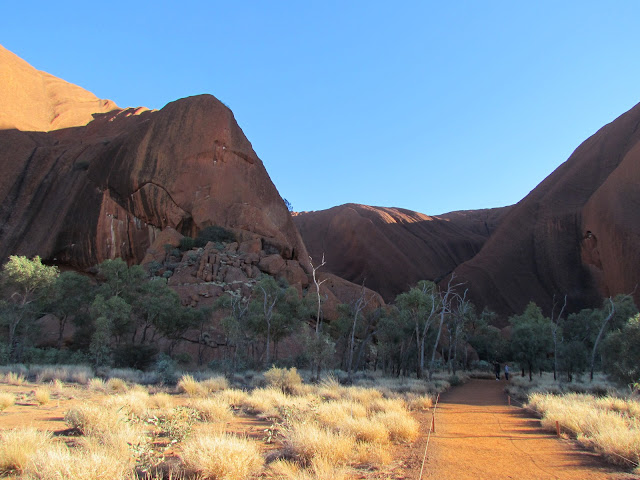Today we were up at 5.30am to be at the Sunrise Viewing Area.
Driving to the rock it was showing O degrees in the car so it was a chilly viewing.
Kata Tjuta (The Olgas) off in the distance as the sun hits to top of the rocks.
Kata Tjuta and Uluru were formed when a shallow basin under the sea received sediments over millions of years. Uluru was mainly sand which was compressed over millions of years more and then a huge upthrust turned the sandstone 90 degrees on it's way up.
Kata Tjuta had more small stones as well as the sediment and this formed conglomerate rock which was also upthrust but turned only 15 to 20 degrees from the horizontal.
Both Kata Tjuta and Uluru are the visible tips of huge rock slabs that extent possibly 6km below the ground.
After sunrise we headed off on the Base Walk a 10.6km full circuit of the rock. We commenced the circuit on the Kuniya Walk to Mutitjulu Waterhole, this is home of Wanampi, an ancestral watersnake. This is a living cultutal landscape. Kuniya is still here. Her spirit is here. The art caves are still used by Anangu today. This is a special place. The cave and rock formations along this walk relate to the activities of Minyma Kuniya (woma python woman) and Wati Liru (poisonous snake man) during the Tjukurpa (Creation Time).
This small cave made a good place for boys to hide and watch the men hunt animals at the Mutitjulu waterhole. The painting in this cave our teachings of senior men to nyiinka (a boy at an important stage of life where he is ready to learn to become a wati (man). They are separated from there family and taught by their grandfathers for this period. This could last up to several years until the boys proved there hunting skills, self reliance and discipline. The people have a responsibility to keep the land and cultural tradions strong and healthy.
Mutitjulu cave is a family cave. For many generations anangu families camped here. The men would hunt for kuka (meat) and the women and children would collect mai (bush food). The food would be bought back here to share. At night around the campfire generations of people told stories teaching the children about this place and painting on the rock. Today these stories are still kept and handed down to the children.
By the time we walked to this part of the circuit the wind chill was making it fell sub zero almost, we had all that we had on about five layers including wet weather gear and we were just ok.
Then around another turn in the rock and it was a lot warmer maybe 3 degrees.
We walked through acacia woodlands and grassed claypans. The snake like grooves at the base of the rock show Kuniya's journey to Mutitjulu Waterhole.
The Kitchen Cave, women girls and small children would camp here. The woman would go out and hunt for mai (bush food) and bring it here for processing. The minymas (woman) would teach girls (kungkas) this knowledge so they could teach there children, this knowledge is still passed on today.
The old people's cave, this is where the old people sat, you can see the cave is blackened by the fires. During mala ceremonies the men who were too old to participate would sit in the cave to rest. They would make sure that the women and children would not enter the men's ceremonial area.
Kantju Gorge this waterhole was the main source of water during the mala ceremonies and generations of their people. They would always approach from the side so as not to frighten away any animals at the waterhole.
Kulpi Nyiinkaku the teaching cave, the anangu people taught nyiinka (bush boys) in this cave how to travel in this country and survive. Generations of grandfathers painted these pictures like a teacher uses a school board to teach them how to track and hunt Kuka (food animals). They would then be taken into the bush to learn about country, where the waterholes are, where to source animals and where to source materials for tools and weapons.
After our base walk we returned to the motel for a rest before returning to the rock for sunset.


































No comments:
Post a Comment